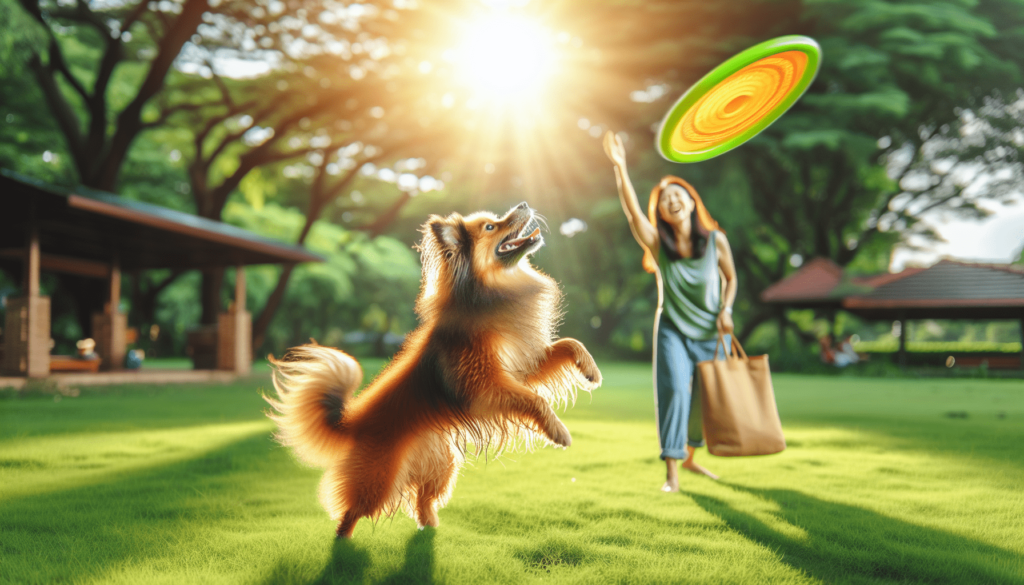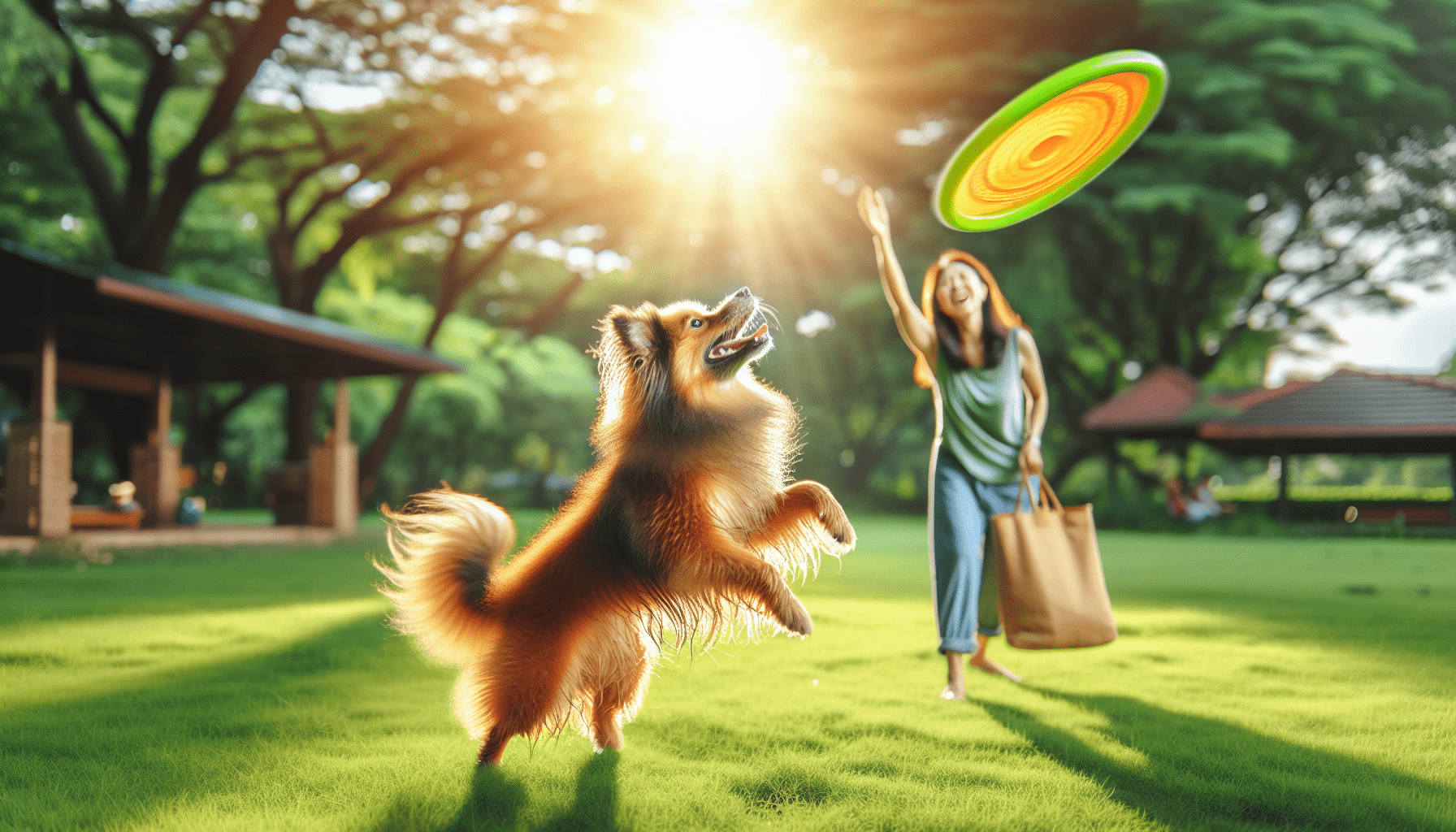If you want to have a blast playing fetch with your furry best friend, this article is just what you need! Discover the secrets to training your dog to play fetch perfectly, whether you’re starting from scratch or looking to improve their skills. With a few simple steps and a whole lot of patience, you’ll soon have your canine companion fetching like a pro, bringing joy and excitement to your playtime sessions together. Get ready to unleash the fetch champion within your four-legged pal!
Choose the Right Equipment
Select the Right Fetch Toys
When training your dog to play fetch, it’s important to choose the right toys that will capture their interest and be suitable for the game. Look for toys specifically designed for fetch, such as tennis balls or rubber balls. These toys are easy to throw and provide a good grip for your dog to pick up with their mouth. Avoid toys that are too small or have detachable parts that could be a choking hazard. Choose toys that are durable and can withstand your dog’s play style.
Get a Durable Fetch Stick or Ball
For dogs who enjoy chewing, it’s important to invest in a durable fetch stick or ball. Look for toys made of tough materials such as rubber or nylon, as these are less likely to be destroyed by your dog’s sharp teeth. Avoid toys that are too fragile or easily breakable, as they won’t last long during fetch training sessions. A durable fetch stick or ball ensures that your dog can have a fun and safe playtime without the risk of ingesting small pieces.
Consider a Fetch Launcher for Extra Distance
If you have a high-energy dog who loves to run and chase, a fetch launcher can be a great addition to your training routine. These devices are designed to throw the ball at longer distances, giving your dog a good run while retrieving. Fetch launchers are also helpful if you have physical limitations that prevent you from throwing the ball far enough. Just make sure to choose a fetch launcher that is suitable for your dog’s size and strength to avoid any injuries.
Start with Basic Training
Teach Basic Commands
Before introducing fetch, it’s important to ensure that your dog has a good grasp of basic commands such as “sit,” “stay,” and “come.” These commands lay the foundation for a well-behaved and obedient dog during fetch training. Take some time to work on these commands using treats and positive reinforcement. By establishing a strong foundation, your dog will be more responsive and attentive during fetch training sessions.
Work on Positive Reinforcement
Positive reinforcement is the key to successful training. Whenever your dog exhibits behavior that you want to encourage, such as picking up the toy or bringing it back to you, reward them with treats, praise, and affection. This positive association will motivate your dog to continue engaging in the desired behavior. Remember to be patient and consistent with your rewards, as this will help your dog understand what you expect from them.
Focus on Bonding and Trust
Fetch training is not just about teaching your dog a game; it’s also an opportunity to build a strong bond and trust between you and your furry friend. Take the time to interact and engage with your dog during training sessions. Show them love, attention, and lots of cuddles. By creating a positive and loving environment, your dog will feel safe and secure, making the training process more enjoyable for both of you.

Introduce the Fetch Concept
Teach ‘Drop It’ Command
Before your dog can play fetch, they need to understand the “drop it” command. This command teaches your dog to release the toy from their mouth willingly. Start by offering a treat or a toy that your dog is not as interested in. When they pick it up, say “drop it” and offer a more enticing treat or toy as a reward for releasing it. Practice this command in various situations, gradually moving on to the actual fetch toy once your dog has a clear understanding of “drop it.”
Use a Regular Toy to Initiate Fetch
To introduce the concept of fetch, start by using a regular toy that your dog is familiar with and enjoys playing with. Toss the toy a short distance and encourage your dog to retrieve it. Use excited and encouraging tones of voice to motivate them to chase after the toy. If your dog brings the toy back to you, reward them with treats, praise, and lots of excitement. Repeat this process several times until your dog starts to understand the game of fetch.
Reward with Treats and Praise
During fetch training sessions, it’s important to reward your dog’s efforts with treats and praise. Every time your dog retrieves the toy and brings it back to you, show your appreciation by giving them a treat and showering them with praise. Positive reinforcement is a powerful tool in encouraging your dog to continue playing fetch. Remember to vary the treats and use high-value rewards to keep your dog motivated and engaged.
Progress to Fetch Training
Start in a Controlled Environment
When first starting fetch training, it’s best to begin in a controlled environment such as your backyard or a quiet, enclosed area. This minimizes distractions and allows your dog to focus on the game. As your dog becomes more proficient at fetch, you can gradually move to different locations and introduce more distractions. Starting in a controlled environment sets your dog up for success and helps them develop the skills and confidence needed for more challenging fetch sessions.
Throw the Toy Short Distances
In the beginning stages of fetch training, it’s important to throw the toy short distances to keep it manageable for your dog. Start with only a few feet away and gradually increase the distance as your dog becomes more comfortable and confident. Remember to throw the toy in a way that is safe and easy for your dog to retrieve. Aim for a distance that allows your dog to easily chase after the toy without getting overwhelmed.
Encourage Retrieval with Excitement
During fetch training sessions, it’s important to use your tone of voice and body language to encourage your dog to retrieve the toy. Use excited and enthusiastic tones when calling your dog and throwing the toy. Clap your hands, cheer, and use gestures that convey excitement. This positive energy will help motivate your dog and make the game of fetch more enjoyable for them. Remember to praise and reward your dog for each successful retrieval.
Prompt ‘Come’ Command after Retrieval
Once your dog retrieves the toy, it’s important to prompt them to bring it back to you. Use the command “come” or any other cue that your dog is familiar with. Encourage them to bring the toy back to you by using a happy and inviting tone of voice. If your dog is having trouble understanding the command, you can gently guide them towards you using a treat or by crouching down and opening your arms. Remember to reward your dog with treats and praise when they successfully bring the toy back to you.

Train for Extended Distance
Gradually Increase Throwing Distance
As your dog becomes more proficient at fetch, you can gradually increase the throwing distance. Aim for a distance that challenges your dog without overwhelming them. Start by adding a few feet to the previous distance and gradually work your way up. This gradual increase will help build your dog’s endurance and confidence in retrieving the toy from longer distances. Remember to always take your dog’s physical limitations and energy levels into consideration when increasing the throwing distance.
Use Fetch Launchers to Enhance Distance
If you want to take fetch training to the next level and give your dog an extra challenge, consider using a fetch launcher to enhance the throwing distance. These devices are designed to launch the toy at a greater distance, simulating a longer throw without exerting too much physical effort on your part. Using a fetch launcher can be a fun and rewarding experience for your dog, as it allows them to sprint and chase after the toy over a greater distance.
Reward Longer Retrievals with Extra Praise
As your dog starts to retrieve the toy from extended distances, make sure to reward them with extra praise and encouragement. Longer retrievals require more effort and energy from your dog, so it’s important to acknowledge their hard work. Shower them with extra love, treats, and praise to let them know how proud you are of their progress. This positive reinforcement will motivate your dog to continue improving their fetch skills.
Improve Accuracy and Consistency
Work on Precise Throws
To keep fetch engaging and enjoyable for your dog, it’s important to work on your throwing skills. Aim for accurate and consistent throws, allowing your dog to easily track and retrieve the toy. Practice your throwing technique to ensure the toy lands in a spot that is readily accessible for your dog. Avoid throwing the toy too high or too far to prevent discouragement and ensure a successful fetch experience every time.
Practice Repetition for Consistency
Consistency is key when training your dog to play fetch. Repetition helps reinforce the desired behavior and helps your dog understand what you expect from them. Practice fetch training regularly, at least a few times a week, to maintain consistency. By consistently playing fetch with your dog, you’re reinforcing their understanding of the game and improving their skills over time. Make sure to vary the locations and throwing distances to keep the game interesting and challenging.
Use Verbal Encouragement and Hand Signals
In addition to positive reinforcement and repetition, verbal encouragement and hand signals can help improve the accuracy and consistency of fetch training. Use clear and consistent verbal cues to indicate when it’s time to play fetch or when your dog should bring the toy back to you. Similarly, use hand signals such as pointing or waving your hand to guide your dog during fetch. By combining verbal and visual cues, you’re providing clear and concise instructions that your dog can easily understand.
Address Common Challenges
Dealing with Lack of Interest
If your dog seems disinterested or unmotivated during fetch training sessions, it’s important to address this challenge. First, make sure that you’re using toys or treats that truly capture your dog’s interest. Experiment with different types of toys, treats, or even play in different environments to make fetch more appealing. Additionally, make sure that your dog is mentally and physically ready to engage in fetch. A tired or distracted dog may not be as interested in playing fetch, so consider adjusting the timing or duration of your training sessions.
Overcoming Fear or Anxiety
Some dogs may exhibit fear or anxiety when it comes to playing fetch, especially if they have had negative experiences in the past. If your dog shows fear or reluctance towards fetch, it’s important to go at their pace and create a positive and safe environment. Use positive reinforcement to gradually build their confidence and desensitize them to the game. You can start by playing fetch in a calm and quiet setting and gradually introduce more distractions as your dog becomes more comfortable.
Troubleshooting Unwillingness to Drop the Toy
If your dog is unwilling to drop the toy after retrieving it, it’s important to address this challenge early on. Start by reinforcing the “drop it” command during fetch training sessions. Whenever your dog retrieves the toy, ask them to “drop it” and offer a treat or a more enticing toy as a reward for releasing it. If your dog continues to hold onto the toy, avoid pulling or forcing it out of their mouth, as this may escalate the situation. Instead, seek the help of a professional trainer who can provide guidance on how to safely and effectively address this issue.
Make Fetch Fun and Engaging
Add Variations to Keep it Exciting
To keep fetch training fun and engaging for your dog, add variations to the game. Change the throwing distance, play in different environments, or introduce new toys to keep things interesting. You can also try incorporating different obstacles or challenges into the fetch game, such as having your dog retrieve the toy from a specific spot or navigating around objects. Adding variations prevents fetch from becoming monotonous and ensures that your dog stays mentally and physically stimulated.
Incorporate Fetch into Playtime
Fetch doesn’t have to be a standalone activity; you can incorporate it into your regular playtime with your dog. By seamlessly blending fetch into your play routines, you’re reinforcing the idea that fetch is a fun and rewarding game. Combine fetch with other activities such as tug-of-war or hide-and-seek to create a dynamic and engaging playtime experience for your dog. This not only keeps them entertained but also strengthens the bond between you and your furry friend.
Consider Group Fetch Sessions
If your dog enjoys socializing and playing with other dogs, consider organizing group fetch sessions. This allows your dog to interact with other dogs while honing their fetch skills. Group fetch sessions can be a great opportunity for your dog to learn from their peers, burn off excess energy, and enjoy a playtime experience that is both stimulating and social. Just make sure to choose an appropriate and safe location for these sessions, and supervise your dog’s interactions to ensure everyone’s safety.
Maintain a Regular Fetch Routine
Designate Fetch Sessions
To maintain consistency and ensure that fetch training remains a regular part of your dog’s routine, designate specific fetch sessions. Set aside dedicated time slots each week for fetch training and stick to those schedules as much as possible. By establishing a consistent routine, you’re creating structure and predictability for your dog, which helps them understand and anticipate when it’s time to play fetch. Consistency is key in reinforcing the behavior and skills learned during fetch training.
Establish a Fetch Schedule
In addition to designated fetch sessions, it can be helpful to establish a fetch schedule. Determine how often you want to play fetch with your dog and create a weekly or monthly schedule accordingly. This schedule can help you plan around your other commitments and ensure that you’re consistently providing your dog with mental and physical exercise through fetch. Remember to be flexible and adjust the schedule as needed to accommodate your dog’s energy levels and any other factors that may affect their participation in fetch training.
Stick to Consistent Training
Consistency is vital in fetch training. Stick to your training routine and avoid skipping sessions unless absolutely necessary. Regular training sessions help reinforce the desired behavior and allow your dog to progress at a steady pace. Skipping sessions can disrupt the training process and make it harder for your dog to understand and remember the game of fetch. Be committed and dedicated to providing your dog with consistent training, and you’ll see the rewards in their development and skills.
Enjoy the Benefits of Fetch
Physical Exercise and Mental Stimulation
Playing fetch provides your dog with a great outlet for physical exercise and mental stimulation. The running, chasing, and retrieving involved in fetch help keep your dog physically fit and prevent boredom-related behaviors. Fetch also stimulates their cognitive abilities as they learn to track the toy, gauge distances, and follow commands. By incorporating fetch into your dog’s routine, you’re providing them with a well-rounded and fulfilling mental and physical workout.
Bonding and Strengthening the Human-Canine Relationship
Fetch training is an excellent opportunity to strengthen the bond between you and your dog. The shared activity, positive reinforcement, and quality time spent together during fetch sessions enhance the human-canine relationship. By engaging in fetch, you’re creating a positive association between you and your dog, building trust, and deepening your connection. The joy and excitement that both you and your dog experience during fetch training create lasting memories and strengthen the bond over time.
Building Trust and Obedience Skills
Fetch training allows you to work on trust and obedience skills with your dog. By practicing basic commands such as “come” and “drop it” during fetch, you’re reinforcing the foundations of obedience and building trust. As your dog learns to listen to your commands and willingly release the toy, they are developing important obedience skills that can be applied in other areas of their life. Fetch training provides a structured and engaging environment to nurture these skills, helping your dog become a well-behaved and obedient companion.

